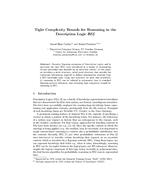LATPub580: Unterschied zwischen den Versionen
Aus International Center for Computational Logic
Marcel Lippmann (Diskussion | Beiträge) KKeine Bearbeitungszusammenfassung |
İsmail İlkan Ceylan (Diskussion | Beiträge) KKeine Bearbeitungszusammenfassung |
||
| Zeile 1: | Zeile 1: | ||
{{Publikation Erster Autor | {{Publikation Erster Autor | ||
|ErsterAutorVorname= | |ErsterAutorVorname=İsmail İlkan | ||
|ErsterAutorNachname=Ceylan | |ErsterAutorNachname=Ceylan | ||
|FurtherAuthors=Rafael Peñaloza | |FurtherAuthors=Rafael Peñaloza | ||
| Zeile 7: | Zeile 7: | ||
|Referiert=1 | |Referiert=1 | ||
|Title=Tight Complexity Bounds for Reasoning in the Description Logic BEL | |Title=Tight Complexity Bounds for Reasoning in the Description Logic BEL | ||
|To appear=0 | |||
|Year=2014 | |Year=2014 | ||
|Booktitle=Proceedings of the 14th European Conference on Logics in Artificial Intelligence (JELIA 2014) | |Booktitle=Proceedings of the 14th European Conference on Logics in Artificial Intelligence (JELIA 2014) | ||
|Pages=77-91 | |Pages=77-91 | ||
|Publisher=Springer | |Publisher=Springer | ||
|Editor=Eduardo Fermé and João Leite | |||
|Series=Lecture Notes in Computer Science | |Series=Lecture Notes in Computer Science | ||
|Volume=8761 | |Volume=8761 | ||
| | |Organization= | ||
}} | }} | ||
{{Publikation Details | {{Publikation Details | ||
|Abstract=Recently, Bayesian extensions of Description Logics, and in particular the logic BEL, were introduced as a means of representing certain knowledge that depends on an uncertain context. In this paper we introduce a novel structure, called proof structure, that encodes the contextual information required to deduce subsumption relations from a BEL knowledge base. Using this structure, we show that probabilistic reasoning in BEL can be reduced in polynomial time to standard Bayesian network inferences, thus obtaining tight complexity bounds for reasoning in BEL. | |Abstract=Recently, Bayesian extensions of Description Logics, and in particular the logic BEL, were introduced as a means of representing certain knowledge that depends on an uncertain context. In this paper we introduce a novel structure, called proof structure, that encodes the contextual information required to deduce subsumption relations from a BEL knowledge base. Using this structure, we show that probabilistic reasoning in BEL can be reduced in polynomial time to standard Bayesian network inferences, thus obtaining tight complexity bounds for reasoning in BEL. | ||
|Download=CePe-JELIA14.pdf | |Download=CePe-JELIA14.pdf | ||
|Forschungsgruppe=Automatentheorie | |Forschungsgruppe=Automatentheorie | ||
}} | }} | ||
Aktuelle Version vom 19. Juni 2015, 16:41 Uhr
Tight Complexity Bounds for Reasoning in the Description Logic BEL
İsmail İlkan Ceylanİsmail İlkan Ceylan, Rafael PeñalozaRafael Peñaloza
İsmail İlkan Ceylan, Rafael Peñaloza
Tight Complexity Bounds for Reasoning in the Description Logic BEL
In Eduardo Fermé and João Leite, eds., Proceedings of the 14th European Conference on Logics in Artificial Intelligence (JELIA 2014), volume 8761 of Lecture Notes in Computer Science, 77-91, 2014. Springer
Tight Complexity Bounds for Reasoning in the Description Logic BEL
In Eduardo Fermé and João Leite, eds., Proceedings of the 14th European Conference on Logics in Artificial Intelligence (JELIA 2014), volume 8761 of Lecture Notes in Computer Science, 77-91, 2014. Springer
- KurzfassungAbstract
Recently, Bayesian extensions of Description Logics, and in particular the logic BEL, were introduced as a means of representing certain knowledge that depends on an uncertain context. In this paper we introduce a novel structure, called proof structure, that encodes the contextual information required to deduce subsumption relations from a BEL knowledge base. Using this structure, we show that probabilistic reasoning in BEL can be reduced in polynomial time to standard Bayesian network inferences, thus obtaining tight complexity bounds for reasoning in BEL. - Forschungsgruppe:Research Group: AutomatentheorieAutomata Theory
@inproceedings{CP2014,
author = {{\.{I}}smail {\.{I}}lkan Ceylan and Rafael Pe{\~{n}}aloza},
title = {Tight Complexity Bounds for Reasoning in the Description Logic
{BEL}},
editor = {Eduardo Ferm{\'{e}} and Jo{\~{a}}o Leite},
booktitle = {Proceedings of the 14th European Conference on Logics in
Artificial Intelligence (JELIA 2014)},
series = {Lecture Notes in Computer Science},
volume = {8761},
publisher = {Springer},
year = {2014},
pages = {77-91}
}
